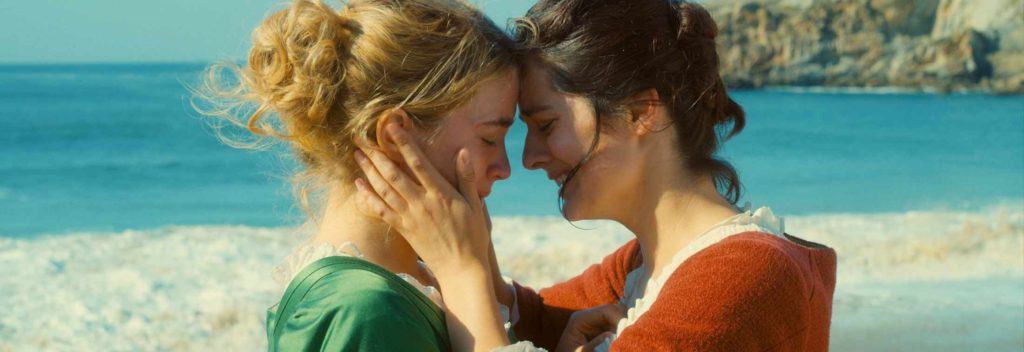“His longing eyes, impatient, backward cast / To catch a lover’s look, but look’d his last; / For, instant dying, she again descends, / While he to empty air his arm extends.” The legend of Orpheus and Eurydice recounts how Orpheus, the fabled poet and philosopher, violated Hades’ conditions for his dead lover Eurydice’s release from the underworld by turning to cast her a forbidden glance, and in so doing condemning her to Hell forever.
This tale has occupied artists – from Ovid to Monteverdi to Jerry Garcia – across millenia. In Portrait of a Lady on Fire, director Céline Sciamma presents the story anew. This is a film about looking, and about the desire which innervates the compulsion to look, to keep looking, and, sometimes, to look away.
Against the backdrop of an achingly remote aristocratic estate along the wild cliffs of Brittany in pre-revolutionary France, an artist named Marianne (Noémie Merlant) has been commissioned to paint the portrait of a young woman named Héloïse (Adèle Haenel) for a Milanese nobleman, a stranger to whom she is unhappily betrothed.
Marianne’s mandate is not easy: Héloïse, angry and proud, refuses to sit for her portrait. So Marianne poses as her companion, observing her subject voraciously as they walk by the cliffs and sit together on the feral beach, mostly in silence, painting Héloïse secretly from memory.
Sciamma arranges composed shots illuminated by lambent candles and cracks of sunlight, largely silent save for moments of spare, symbolic dialogue, creating a series of tableaux that reflects the irreality of the world the two women share.
The climactic revelation of the film arrives not when Marianne confesses her true assignment to Héloïse, but later, when Héloïse reveals that the currents of observation flow in both directions: she is looking back at Marianne. This is the first subversion of the Orpheus myth; Eurydice, too, can choose to look. The ripening tension of mutual observation is communicated through alternating close-ups of the women, both unyielding in their intensity and grace, as they watch each other. They take turns, each glance lingering longer than the last as they verge dangerously on contact, the moments between their gazes diminished to milliseconds. Sciamma forces us to wait, breathlessly, for their eyes to finally meet.
This consummation, which for Marianne and Héloïse precedes physical contact, happens when the two women accompany a young maid, Sophie (Luàna Bajrami), to a quasi-pagan festival. Standing together around a bonfire, the village women in attendance raise their voices in ethereal harmony, repeating a single Latin phrase – fugere non possum (“we cannot escape”) – in an overpowering crescendo as Marianne and Héloïse stare at each other across the flames, the space between them shimmering with heat.
In placing the painter and her subject opposite one another, Sciamma invents a moment of sublime equality. It is this equality, she demonstrates, that is a prerequisite for love.
But complete as this moment is, Sciamma is also concerned with what lies beyond the frame: namely, men, and the rules they enforce. The majority of the action transpires in a utopian universe apart from the patriarchal and socioeconomic strictures that constrain our protagonists’ pasts and futures. And while the film can certainly serve as a feminist manifesto, the absence of men is less a thesis than it is a device, helping Sciamma to draw a diagram of liberated desire.
In the film’s sole moment of pure exposition, Héloïse reads aloud the story of Orpheus and Eurydice from Ovid’s Metamorphoses. The scene is one of Haenel’s transcendent moments; she reads hungrily, her face flushed and her elbows rooted to the table. When she reaches the tragic climax of the story, she pauses so that the three women – Héloïse, Marianne, and Sophie – can debate the central, intractable enigma of the legend, and of the film itself: why did Orpheus look? Was it a compulsive instinct, something beyond his control? Did, as Héloïse suggests, Eurydice ask him to look back? Or, as Marianne contends, did Orpheus make the poet’s choice instead of the lover’s, preferring to crystallize his love in a single dramatic instant rather than continuing to live it out in mundane days, weeks, and years?
Flouting Ovid’s warning, and without resolving his puzzle, Marianne and Héloïse continue to look at one another. In the world Sciamma creates, unburdened by either mythic morality or social repression, to observe is to be in power, to be observed is to be desired, and the place those two meet is love.
Portrait of a Lady On Fire is playing at Village East Cinema, BAM, Cobble Hill Cinemas, Angelika Film Center, and Nitehawk Cinema.
Discover more from Red Hook Star-Revue
Subscribe to get the latest posts sent to your email.












